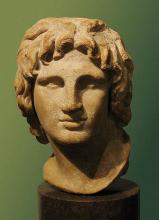According to the 1st century CE Greek historian, Plutarch, Alexander the Great met (well, captured and met) ten gymnosophists on the banks of the Indus. Gymnosophist is Greek for naked philosopher—our sadhus and yogis—and Sikandar, Plutarch says, was aware of their wisdom and posed a philosophical question to each of them. These included:
- Q: "Which are more numerous, the living or the dead?"
A: "The living, since the dead no longer exist." - Q: "Does the earth or the sea produce larger animals?"
A: "The earth, since the sea is but a part of the earth." - Q: "Which animal is the most cunning?"
A: "That which up to this time man has not discovered." - Q: "Why did you induce Sabbas [local chieftain] to revolt?"
A: "Because I wished him either to live nobly or to die nobly." - Q: "Which, in your opinion, is older, day or night?"
A: "Day, by one day"; and he added, upon the king expressing amazement, that hard questions must have hard answers. - Q: "How can a man be most loved?"
A: "If he is most powerful, and yet does not inspire fear." - Q: "How can one become a god instead of man?"
A: "By doing something which a man cannot do" - Q: "Which is the stronger, life or death?"
A: "Life, since it supports so many ills." - Q: "How long is it well for a man to live?"
A: "Until he does not regard death as better than life."
The gymnosophists that Alexander encountered were, it is theorised, very likely an old sect of Naga sadhus, who live naked. Others surmise that they might have been Digambara Jains who are also "skyclad". Alexander gave all the sadhus presents and dismissed them unharmed.

